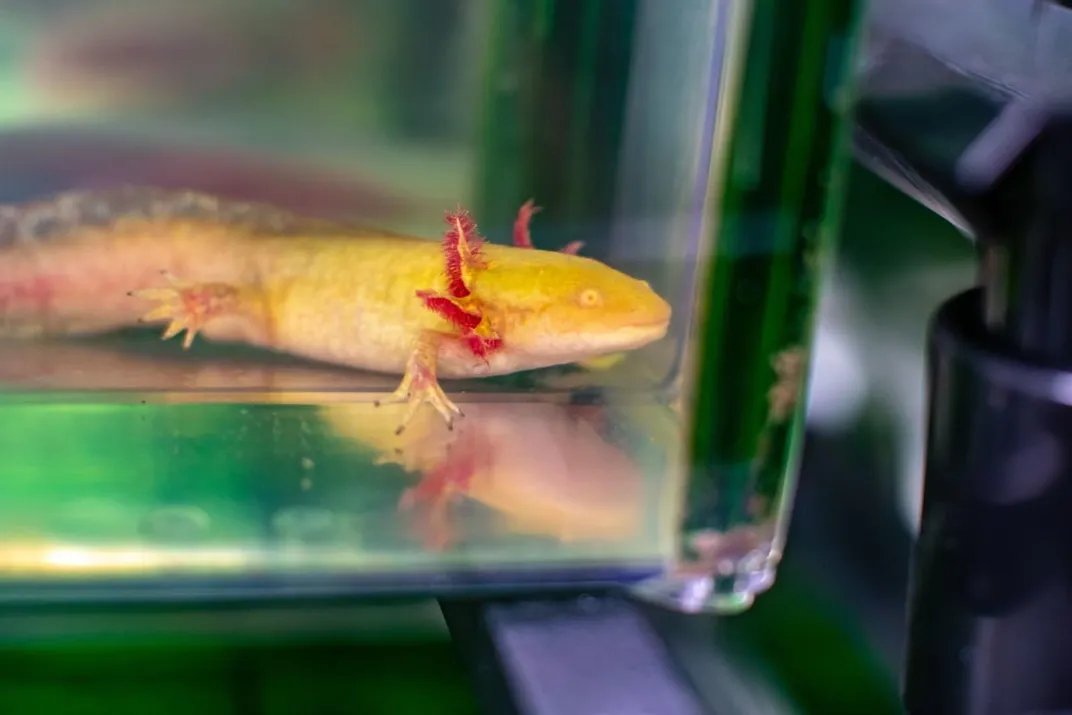Complete Axolotl Genome Could Reveal the Secret of Regenerating Tissues
The aquatic salamander’s genome is one of the most complex sets of genetic instructions in the world
/https://tf-cmsv2-smithsonianmag-media.s3.amazonaws.com/filer/88/b6/88b61700-8658-4961-ad71-552c60dc0e9a/gettyimages-503903108.jpg)
When Lake Xochimilco near Mexico City was Lake Texcoco, and the Aztecs founded their island capital city of Tenochtitlan in 1325, a large aquatic salamander thrived in the surrounding lake. The axolotl has deep roots in Aztec religion, as the god Xolotl, for whom the animal is named, was believed to have transformed into an axolotl—although it didn’t stop the Aztecs from enjoying a roasted axolotl from time to time. The custom of eating axolotl continues to this day, although the species has become critically endangered in the wild.
Saving the salamander that Nature called “biology’s beloved amphibian” takes on a special significance given the animal’s remarkable traits. Axolotls are neotenic, meaning the amphibians generally do not fully mature like other species of salamander, instead retaining their gills and living out their lives under water as a kind of juvenile. On rare occasions, or when stimulated in the lab, an axolotl will go through metamorphosis and develop lungs to replace its gills.
Accompanying these unique traits is a remarkably complex genome, with 32 billion base pairs compared to about 3 billion base pairs in human DNA. The axolotl has the largest genome ever fully sequenced, first completed last year by a team of European scientists. The University of Kentucky, which heads axolotl research in the United States, today announced that researchers have added the sequencing of whole chromosomes to the European effort—“about a thousand-fold increase in the length of assembled pieces,” according to Jeremiah Smith, an associate biology professor at the University of Kentucky. Scientists hope to use this new data to harness some of the axolotl’s unique abilities.

Like other salamanders, axolotls have the ability to completely regenerate an entire limb when lost. “Salamanders have this unique ability to regenerate almost anything you cut off them,” Smith says. Salamanders can even regenerate spinal cords, eyes and parts of their brains.
While the ability to regrow an entire arm is out of reach for humans, studying the axolotl genome could reveal genetic methods of regenerating tissue that could be used in medical research. Smith says that the axolotl’s regeneration capabilities involve the use of stem cells, as well as an unknown method of causing cells at the site of the injury to revert to stem cells.
“Axolotls have been a model species for over 150 years,” Smith says. The sequencing of this genome, the culmination of decades of work for some of the scientists involved, represents a huge milestone as it will allow work to hone in on the specific gene interactions that allow axolotls to regenerate limbs. Smith says his team is now working with the European group to continue to improve and polish the genome assembly.
David Gardiner, a biology professor at the University of California Irvine who has worked with axolotls and studied regeneration for decades, says that the genes that control regeneration aren’t necessarily unique to salamanders.
“Salamanders are not special. It’s not that they have special regeneration genes,” Gardiner says. Though salamanders do regulate their genes differently from other species. The goal is to eventually find a way to signal pathways between genes and activate the ability to regenerate genetic material and ultimately tissue. Such a process could be possible using a type of “smart bandage” that activates certain pathways, or by triggering the process with a gene-editing tool such as CRISPR-Cas9.
However, “you couldn’t do that if you didn’t know what those regions are,” Gardiner says. He says the “herculean effort” by Smith and his colleagues to sequence the genome will help move this process along.
The research is also expected to advance scientists’ understanding of genetics at large. “It’ll take our understanding to the next level,” Gardiner says. When it comes to regeneration, scientists are interested in how some genes can affect and interact with others thousands of base pairs away.
/https://tf-cmsv2-smithsonianmag-media.s3.amazonaws.com/filer/27/fd/27fd4b75-323a-4813-a5f0-8b4956f67f41/ezgifcom-resize_4.jpg)
Smith and his team have already made use of this new genome map by identifying the gene responsible for causing a heart defect that occurs among axolotls.“They basically don’t develop their hearts properly during early life,” Smith says. The knowledge of the genes responsible for this defect can help scientists understand what may cause some heart problems in humans.
The work also has implications for conservation. While the axolotl may be fairly common in the laboratories of a certain subset of gene scientists, the salamander is actually under a lot of pressure in its singular habitat in the wild. When the Aztec Empire fell to the Spanish, the Europeans converted the indigenous metropolis into Mexico City. The urban area has continued to expand ever since, often at the expense of the wetland habitat that once spread across the Valley of Mexico.
Today, Lake Xochimilco is a shadow of Lake Texcoco. Positioned to the southeast of Mexico City. The area is popular with tourists and weekenders from the city who hire boats in the canal area. According to the International Union for Conservation of Nature, urban water pollution, commercial development, hunting, climate change and invasive species all threaten the remaining wild axolotl population in the canals of Lake Xochimilco.
Luis Zambrano, a biologist at the National Autonomous University of Mexico who works with axolotls, says that genome work enhances the importance of the amphibian conservation in the wild.
“Axolotls can survive in tanks, but its variation can be reduced as the population number and origins are constrained,” Zambrano says in an email.“Generic variation of the wild populations [has] become highly important if we want to use this salamander genome as a system able to help human health.”
The Aztecs knew of the axolotl’s regenerative power, and they attributed it to powers imbued by Xolotl. Now, the greatest obstacle to truly understanding the secret of this seemingly divine ability is the threat we pose to the very animal we hope to learn from.
/https://tf-cmsv2-smithsonianmag-media.s3.amazonaws.com/accounts/headshot/joshua-learn_copy.jpg)
/https://tf-cmsv2-smithsonianmag-media.s3.amazonaws.com/accounts/headshot/joshua-learn_copy.jpg)